 |
|
 |
|
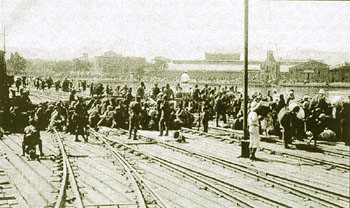 The Last Obstacle at Smyrna's Harbour--The railway dock, approximately 400 metres long, with a lot of rails along the harbour. Those who wanted to leave, after thronging to reach the head of the dock, also had to pass 4 check-points, where Turkish soldiers would cull out those who did not have permission to travel. At each check-point, those who could not leave were guided back to the captives' queues. They waited there until they would be transferred to somewhere else. On the left, the captives and the Turkish solders who were guarding them can be discerned. On the right, another group consisting of women and children carrying packages on their backs was preparing to embark on the ships. Those who were to embark had to pass through a body inspection and paper check four times. A British sailor was standing next to the telegraph pole in the foreground, while a little behind, at the gate, an American sailor was standing at the checkpoint. |
Translation into English by Joanna Michalakelli Original article appeared in Palmoi tis Vatoussas [quarterly publication of Vatoussa, Lesvos], Vol. 25 (Jan.-Mar. 2004), pp 17-20.
|
|
After the collapse of the front, about 30,000 Greek refugees came to Smyrna daily, not including those who had fled to other coastal cities. All those people settled down in churches, in relatives' houses, in cemeteries and any other place someone could imagine. With fear intensely depicted on their face, these refugees wanted to abandon Asia Minor by any means and pass to free Greece. With the collapse of the front and the disbanding of the biggest part of the Asia Minor Army, Smyrna also became that main centre crossed by our soldiers, who headed for Erythraia and Tsesme, so as to ferry across to the Greek islands. At the same time, the Great Powers (USA, England, France, and Italy) sent their ships to Smyrna and disembarked forces, in order to protect their consulates, their missions, their fellow-country people and their citizens. Unfortunately, Field Marshal Chatzianestis, as we had mentioned in the first part of our article, had not estimated the situation correctly and "rested assured," in contrast with the perspicacious Archbishop Chrysostomos who had assessed the situation rightly and predicted the befalling storm. The rapid and tragic development of the military operations obliged the Greek authorities of the city to embark on the ships in order to depart to free Greece together with the soldiers, before the Turkish army would enter Smyrna, abandoning the permanent Greek population of the city and the about 300,000 Greek refugees to their fate, most of whom thronged the quay in the hope of leaving as well. On the 26th of August all the Greek public services had abandoned the city and, with them, Chatzianestis' deputy General Polymenakos. The night that followed was the most agonizing for the Christian population of the city. |
|
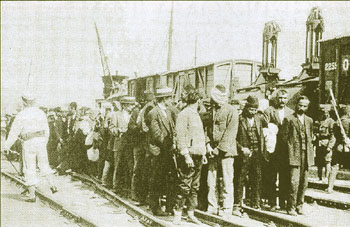 Men selected for exile [From the editors: selection for exile was a death sentence, since the men were never seen or heard from again and reports leaked out to the west that the men were sent on death marches and crucified on wooden crosses by the thousands along interior roads] |
On Saturday morning, on the 27th of August it was rumoured that the Turkish army was approaching and would enter the city. Indeed, at 10:30 the first equestrian Tsetses were already in the centre of Smyrna and headed for the Commandery. The entry of those riders who were wearing black uniforms with the hanging yataghans, took place in some order and created the impression to the Christians that the transfer of the administration of the city from the Greeks to the Turks would take place smoothly. The Turks passed in front of the bolted shops, crossed the streets and raised their left arms, reassuring the terrified Christians, who crowded at the quay and in the nearby streets. However, the illusions soon dissipated. On that same night the acts of murder and pillage by the Turkish soldiers and citizens began, while Major-General Nourentin was undertaking the administration of the city. |
| On the 28th of August, the regular Turkish army entered Smyrna too and then the systematic acts of violence and looting began, the rapes, and murders of all the Christian population, Armenians and Greeks. At first, the Turks' frenzy burst on the Armenians . . . The Armenian district was pillaged savagely, the women were raped, the men were killed, streets filled with disfigured corpses.The 30th of August was the day of the big slaughter of the Armenian people. At the churchyard of Aghios Stephanos alone, 5,000 Armenians were massacred. Afterwards, the Turks' rage burst on the Greeks and the Greek district. On the night of the 31st of August, thousands of Greek people were slaughtered in the churches, in the facilities of the gymnastic club of Panionios, as well as in the nearby cemetery. On the same day, the well premeditated and planned arson of the city also took place. The Turks set fire to many spots in the Armenian and Greek districts of the city, which were discernible because of their dense construction and the many small stores, while they were taking measures so that the fire would not spread to the Turkish neighborhood with its minarets and cypress-trees and to the Frankish quarter with its luxurious houses. The fire spread from house to house, from balcony to balcony, to the lanes and the streets, devoured everything and covered a distance of 2 kilometres [roughly 3 miles] in the direction of the quay, where not only the Greek refugees, but also the Greek permanent residents of Smyrna crowded and increased dangerously, carrying babies and bed-clothes and any other items they gathered at the very last moment. A strong wind drove fire and heat into the faces of those poor people, who soaked the blankets in the sea, so as to relieve themselves. The scenery was reminiscent of hideous moments of hell in Byzantine hagiography, when more then 300,000 terrified souls crowded at the quay, where refugees also had with them wildly neighing horses and screeching camels. The crews of the Great Powers' ships heard the wailing of these poor people who called desperately for help and were thrown or fell into the sea that was full of corpses, since other people were pushing them. And not only did they not offer them any help, but they also threw into the sea those who had managed to climb onto their ships. They all trampled each other with no hope of salvation; on the one hand there was the fire and on the other, the sea. In light of this incredible slaughter and tragedy, which we mentioned, it would be ironical to attempt to enumerate the materials damage. However, its size demonstrates the tragedy of those people. The Smyrniot author and scholar Chr. Solomonidis reports that approximately 43,000 Greek houses were burned, 10,000 Armenian residences, and 1,000 houses that belonged to foreign citizens. Moreover, 5,000 stores were incinerated, 117 Greek and Armenian schools and 43 of the 46 churches of Smyrna and its suburbs. Besides all these, pious institutions, banks, consulates and large buildings at the quay all went up in smoke. The Christian population had encountered such a despairing situation that they were obliged to leave Asia Minor once and for all. Needless to say, the same incidents also took place at the Greek suburbs of Smyrna (Kordelio, Bournovas, and so on) and in all the villages of the area. |
|
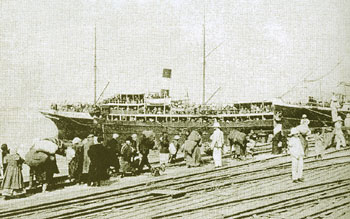 Refugee-laden ship departing from railway dock of Smyrna. British sailors in white uniforms were helping with crowd control during embarkation. 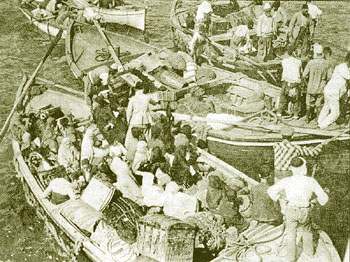 Transport boats ferry homeless people from Smyrna's burned areas to rescue ships anchored in open sea. |
On the following day, the 1st of September, two-thirds of Smyrna was found converted to piles of slowly burning coal. After the fire, 100,000 people left the quay and slipped into any place they could find. The other people, more than 200,000 souls, continued to live there. Others died and some women gave birth in that ghastly place of hell.Famine exterminated them and they ate raw meat from carcasses.The lucky ones tasted some hard tack which was given to them by the American sailors. The sea was full of corpses. At the harbour, the ships of the neutral, formerly allied, Foreign Powers, turned on their lights at night, in order to illuminate the desperate faces. The peak of this atrocity was undoubtedly the tormenting death of the Archbishop of Smyrna Chrysostomos. The respectable hierarch, who did not want to be separated from his flock in any way and had promised to relieve the refugees, was the only Greek authority who refused to abandon Smyrna on the 25th and 26th of August. On the 27th of that month he was first called by the Turkish garrison commander and then by Nourentin. The Archbishop was regarded a traitor of the Ottoman Empire as, despite being a Turkish citizen, he sided with the Greek people during the Greek occupation of Smyrna. Then, Nourentin did the self-evident: he handed the venerable hierarch over to the enraged Turkish mob outside the Commandery so as to be judged by the Turkish people! His incredible maltreatment by the mob followed until a Turk-Cretan, who had been aided by the Archbishop in the past, felt sorry for him and shot him in order to terminate his martyrdom. |
According to Solomonidis, apart from Archbishop Chrysostomos, 347 of the 359 clergymen of the Bishopric of Smyrna were murdered hideously. Some were strangled, some were burned alive, some massacred, and others shot. On the 3rd of September, the military commandant of Smyrna Nourentin issued a manifesto, according to which all the Greeks and Armenians from 18 to 45 years old had to be handed over as captives. The reasons for this decision were that they had turned against the country, that they had fought on the side of the Greeks, that they had performed acts of incredible violence and brutality, that they had burned the cities (the Turks circulated that the Greeks had set the fire in order to take vengeance on the Turks!) The women, the children and elderly men, according to the manifesto, could emigrate until the 30th of September, otherwise they had the right to return to their houses and repeat their peaceful labours! What ensued cannot be described. The refugees crowded and crushed to death at the quay of Smyrna in order to embark on any vessel and depart. In front of the bars, desperate women with children and old people crowded, while behind them, the Turks selected the adolescents and the men, so as to banish them to the inland of Asia Minor, tied with ropes at their wrists. The unexpected appearance of a rescue ship brought tragic death to the throng because from trampling or drowning in the sea. On the first day, 43,000 souls embarked on eight ships. The others would have to wait for other days. Through the Foreign Powers' mediation, Greek ships came from Mytilene and until the 18th of September 180,000 refugees had departed from the harbour of Smyrna. An eight-day extension was also granted by the Turks. The plan predicted that Asia Minor would be emptied of its Christian population. It is estimated that approximately 300,000 people left from the harbour of Smyrna, leaving behind at least 10,000 dead people, while the total number of the thousands of adolescents and men who were exiled to the interior as captives--where incredible torture and death awaited them--cannot be estimated accurately. |
|
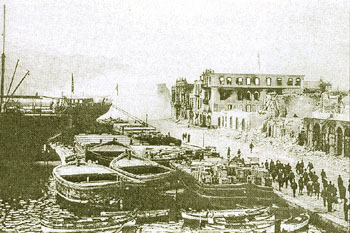 The dynamiting of buildings along quay following the conflagration and massacres in Smyrna. |
As a conclusion to the tragedy of the catastrophe of Smyrna, I will quote a poem of George Horton's (he was the Philhellenic American consul in Smyrna), entitled "The City That Was Martyred." Horton, the USA's consul in the tormented city from 1911 to 1917 and from 1919 until its catastrophe, had a Greek wife and was involved in extensive diplomatic and charitable activities to support the Christian populations of Asia Minor, the Greeks and the Armenians. He was also a notable author; his book that was published, The Blight of Asia, caused a great uproar, because he had the boldness to narrate the real events of the catastrophe of Smyrna and the incidents of persecution and slaughter of the Christian populations of Asia Minor, ascribing the responsibility for all those events not only to Turkish brutality, but also to Western powers, especially to his compatriots. |
I recommend that readers of our magazine find and read this book that is currently being circulated by Estia Publications [From the editors: this publishing group is located in Athens, Greece, affiliated with the foundation in the Nea Smyrni district established by Aristotle Onassis. U.S. Library of Congress description of the original printing of this book is as follows: Horton, George, 1860-1942. The Blight of Asia; an account of the systematic extermination of Christian populations by Mohammedans and of the culpability of certain great powers; with a true story of the burning of Smyrna, by George Horton ... with a foreword by James W. Gerard ...Indianapolis, The Bobbs-Merrill Company [c1926] 292 p. front., plates, ports., maps. 23 cm.]
|
|
(Posted 2005; reformatted February 2007) Mr. Evangelos Gdontelis is one of the principle writers for the Palmoi tis Vatoussas, a very fine quarterly publication produced by the Cultural Organization of Vatoussans Abroad, "Koimisi tis Theotokou." He is a graduate of the University of Athens and a former instructor, as well as an active member and officer of all Vatoussan organizations, including the Christos and Mary Papoutsy Vatoussa Revitalization Foundation. Ms. Michalakelli is an English instructor in Greece, a graduate of the University of Athens now completing her Masters Degree, and a native of Lesvos. She has translated a number of seminal articles for HCS about Greek history, particularly local history on Lesvos. See also her translation of "The Great Frost (or Kais) of 1850 (also authored by Ioannis "John" Manoukas)," and "A Local Law of Old Achyrona (Kalloni) (penned by Christos Stavrakoglou)." HCS readers who have enjoyed this article about history may wish to read more in the HCS Archives section about Smyrna , Byzantine and Modern Greek History, Vatoussa, Hellenic Genealogy, and Travel in Greece. |
|
|
|
